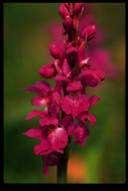Orchid, spy, erect, ... always slender

The Orkidazeo family has a large number of species: About 17,000 species and 750 genera. Despite their abundance in the tropics, in the deserts they hardly appear. About 35 species are known within the genus Orchis in Europe and among them, in the case of the Basque Country, the species Orchis mascula that we studied would be the most common.
This orchid extends very easily in the pastures and meadows of our environment, being relatively abundant in the different forest spaces (beech and oak). It extends from the cliffs of the sea to our summits, from late March to June, where we can see erected, slender and florida.

Variable plant, 15-50 centimeters high, glabrous and upright stem, smooth and cylindrical. The lower part of the stem is formed by 3-5 leaves, extended-lanceadas (often titanic).
The inflorescence consists of a dense, cylindrical spike. The flowers range from pink to purple, with numerous shades. Limiting the species under study, we highlight its abundant flowering. Unpleasant and indefinite smell. In the root has 2-3 tubers (“Orchis” in Greek would be a bulb plant), which are of corn to feed the plant.
Within this genus and in the case of the Basque Country, about 14 species would appear.
Orchids have been used as medicinal plants throughout history (and also in the Basque Country) and this species is one of the most used. For example, in Alava to cure diseases of weakness and prostate. It is also used as an aphrodisiac. In its tubers is a starchy substance (vestige) with which a drink is prepared. These bulbs are very valuable as food, but fortunately it is not economically profitable.
Finally, it should be noted that many of the genres of this family are “persecuted” by collectors... Many species are in a critical situation. We should especially respect these beautiful plants and their habitats... Therefore, we will have the opportunity to act on another.
Family: Orquescriteos |





